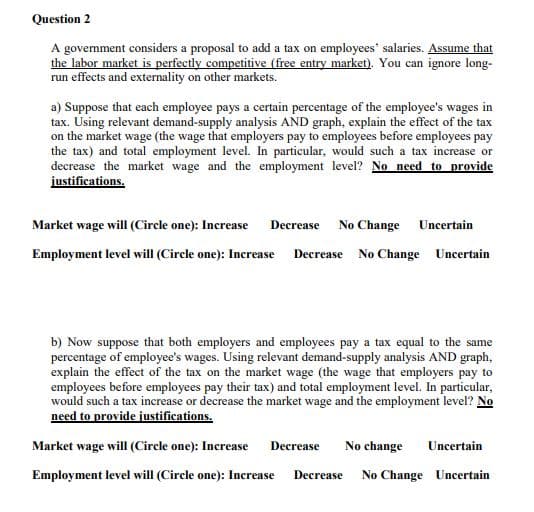Question 2 A government considers a proposal to add a tax on employees' salaries. Assume that the labor market is perfectly competitive (free entry market). You can ignore long- run effects and externality on other markets. a) Suppose that each employee pays a certain percentage of the employee's wages in tax. Using relevant demand-supply analysis AND graph, explain the effect of the tax on the market wage (the wage that employers pay to employees before employees pay the tax) and total employment level. In particular, would such a tax increase or decrease the market wage and the employment level? No need to provide justifications. Market wage will (Circle one): Increase Decrease No Change Uncertain Employment level will (Circle one): Increase Decrease No Change Uncertain b) Now suppose that both employers and employees pay a tax equal to the same percentage of employee's wages. Using relevant demand-supply analysis AND graph, explain the effect of the tax on the market wage (the wage that employers pay to employees before employees pay their tax) and total employment level. In particular, would such a tax increase or decrease the market wage and the employment level? No need to provide justifications. Decrease No change Uncertain Market wage will (Circle one): Increase Employment level will (Circle one): Increase Decrease No Change Uncertain
Question 2 A government considers a proposal to add a tax on employees' salaries. Assume that the labor market is perfectly competitive (free entry market). You can ignore long- run effects and externality on other markets. a) Suppose that each employee pays a certain percentage of the employee's wages in tax. Using relevant demand-supply analysis AND graph, explain the effect of the tax on the market wage (the wage that employers pay to employees before employees pay the tax) and total employment level. In particular, would such a tax increase or decrease the market wage and the employment level? No need to provide justifications. Market wage will (Circle one): Increase Decrease No Change Uncertain Employment level will (Circle one): Increase Decrease No Change Uncertain b) Now suppose that both employers and employees pay a tax equal to the same percentage of employee's wages. Using relevant demand-supply analysis AND graph, explain the effect of the tax on the market wage (the wage that employers pay to employees before employees pay their tax) and total employment level. In particular, would such a tax increase or decrease the market wage and the employment level? No need to provide justifications. Decrease No change Uncertain Market wage will (Circle one): Increase Employment level will (Circle one): Increase Decrease No Change Uncertain
Chapter13: General Equilibrium And Welfare
Section: Chapter Questions
Problem 13.14P
Related questions
Question

Transcribed Image Text:Question 2
A government considers a proposal to add a tax on employees' salaries. Assume that
the labor market is perfectly competitive (free entry market). You can ignore long-
run effects and externality on other markets.
a) Suppose that each employee pays a certain percentage of the employee's wages in
tax. Using relevant demand-supply analysis AND graph, explain the effect of the tax
on the market wage (the wage that employers pay to employees before employees pay
the tax) and total employment level. In particular, would such a tax increase or
decrease the market wage and the employment level? No need to provide
justifications.
Market wage will (Circle one): Increase
Decrease
No Change Uncertain
Employment level will (Circle one): Increase Decrease No Change Uncertain
b) Now suppose that both employers and employees pay a tax equal to the same
percentage of employee's wages. Using relevant demand-supply analysis AND graph,
explain the effect of the tax on the market wage (the wage that employers pay to
employees before employees pay their tax) and total employment level. In particular,
would such a tax increase or decrease the market wage and the employment level? No
need to provide justifications.
Market wage will (Circle one): Increase
Decrease
No change
Uncertain
Employment level will (Circle one): Increase
No Change Uncertain
Decrease
Expert Solution
This question has been solved!
Explore an expertly crafted, step-by-step solution for a thorough understanding of key concepts.
Step by step
Solved in 3 steps with 1 images

Knowledge Booster
Learn more about
Need a deep-dive on the concept behind this application? Look no further. Learn more about this topic, economics and related others by exploring similar questions and additional content below.Recommended textbooks for you


Principles of Microeconomics (MindTap Course List)
Economics
ISBN:
9781305971493
Author:
N. Gregory Mankiw
Publisher:
Cengage Learning

Principles of Economics (MindTap Course List)
Economics
ISBN:
9781305585126
Author:
N. Gregory Mankiw
Publisher:
Cengage Learning


Principles of Microeconomics (MindTap Course List)
Economics
ISBN:
9781305971493
Author:
N. Gregory Mankiw
Publisher:
Cengage Learning

Principles of Economics (MindTap Course List)
Economics
ISBN:
9781305585126
Author:
N. Gregory Mankiw
Publisher:
Cengage Learning

Principles of Economics, 7th Edition (MindTap Cou…
Economics
ISBN:
9781285165875
Author:
N. Gregory Mankiw
Publisher:
Cengage Learning

Principles of Economics 2e
Economics
ISBN:
9781947172364
Author:
Steven A. Greenlaw; David Shapiro
Publisher:
OpenStax

Principles of Microeconomics
Economics
ISBN:
9781305156050
Author:
N. Gregory Mankiw
Publisher:
Cengage Learning